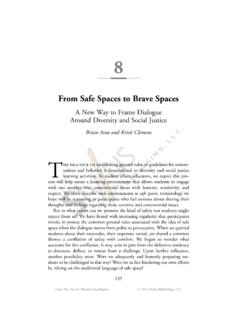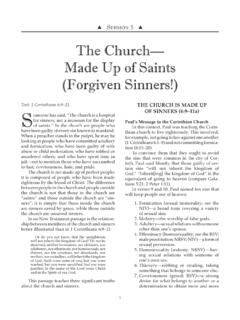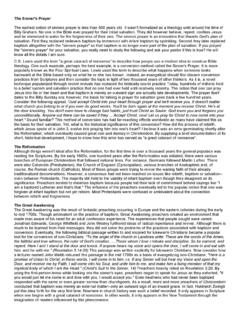Transcription of Anselm’s Cur Deus Homo A Meditation from the Point of View ...
1 The Saint Anselm Journal (Fall 2015) 14 Anselm s Cur Deus Homo: A Meditation from the Point of View of the Sinner Gene Fendt Elements in Anselm's Cur Deus Homo Point quite differently from the usual view of it as the locus classicus for a theory of Incarnation and Atonement which exhibits Christ as providing the substitutive revenging satisfaction for the infinite dishonor God suffers at the sin of Adam. This Meditation will attempt to bring out how the rhetorical ergon of the work upon faith and conscience drives the sinner to see the necessity of the marriage of human with divine natures offered in Christ and how that marriage raises both man and creation out of sin and its defects.
2 This explanation should exhibit both to believers, who seek to understand, and to unbelievers (primarily Jews and Muslims), from a common root, a solution "intelligible to all, and appealing because of its utility and the beauty of its reasoning" ( ). Anselm s Cur Deus Homo is the locus classicus for a theory of Incarnation and Atonement which exhibits Christ as providing the substitutive revenging satisfaction for the infinite dishonor God suffers at the sin of Adam (and company).1 There are elements in it, however, which seem to Point quite differently from such a view. This Meditation will attempt to bring further into the open how the rhetorical ergon of the work upon faith and conscience 2 shows something new in this Paschal event, which cannot be well accommodated to the view which makes Christ a scapegoat killed for our This ergon upon the conscience I take in what I trust is a most suitably monastic fashion to be more important than the theoretical theological shell which Anselm s discussion with Boso more famously leaves behind.
3 That is to say, as is true in Plato, the dialogue s effect/work upon the soul or conscience is more important than any particular intellectual position defended in the dialogue. This reading will show how the aim of this dialogue, for Anselm, is in line with that of his more famous meditations 1 The summary preceding Anselm s works in Fordham University s on-line Medieval Sourcebook is a good indication of the general acceptance of this view (available at ). Unless noted otherwise, for Cur Deus Homo (CDH), I will be using the translation by Sidney Norton Deane in St. Anselm: Proslogium; Monologium; An Appendix in Behalf of the Fool by Gaunilon; and Cur Deus Homo, noted in the text by book and chapter of that edition.
4 2 In responding to Gaunilo, Anselm appeals to his fellow monk s faith and conscience that he understands Anselm s phrases in Proslogion. That whole book aims to arouse us insignificant readers to abandon [ourselves] for a little to God, and rest in him: a not unfitting phrase to summarize the aim of monastic life. See Anselm: Basic Writings, edited and translated by Thomas Williams (Indianapolis: Hackett, 2007); quotations in this note are from Anselm s Reply to Gaunilo, and Preface to Proslogion respectively. 3 Several scholars have recently pointed to the rhetorical work of the dialogue as a matter of significant weight. See Bernd Goebel and Vittorio H sle, Reasons, Emotions and God s Presence in Anselm of Canterbury s Dialogue Cur Deus Homo, Archiv f r Geschicte der Philosophie 87 (2005): 189-210.
5 Eileen Sweeney ends her fine discussion of Cur Deus Homo in Anselm of Canterbury and the Desire for the Word (Washington DC: CUA, 2012) with a problem and a suggestion: the problem is that Anselm s construction of CDH leads to a distorted emphasis on Christ s death (301). The suggestion is to read CDH next to Anselm s Meditation on Human Redemption (MHR), which emphasizes God s design to raise human nature (302). This is an attempt to read that end through CDH, but from within. The Saint Anselm Journal (Fall 2015) 15 Monologion and Proslogion: to return us to our own (monastic) meditations upon Christ with greater fervor and clarity. The title question arises, however, as Anselm is leaving the monastery for the greater world; it is one which many unbelievers consider an objection to Christianity tout court, as well as one which believers seek to understand (CDH ).
6 The unbelievers Anselm must have in mind would be Jews and Muslims, with whom Christians share a belief in the unapproachable holiness of God. Thousands of years of Jewish practice and teaching have grown a deep tap-root regarding this from the seed of Abraham; but only one of these trees flowers. Anselm means to show, from this common root, a solution intelligible to all, and appealing because of its utility and the beauty of its logic ( ).4 Boso grants that while infidels are unwilling to come to faith without reason, those with faith wish to understand what they believe, so the object of our quest is one and the same ( ).5 The forthcoming enquiry, then, will be joint in many more ways than merely between two eleventh century Catholic monks, or between them and us. As Anselm says, it is difficult to understand why God became man in Christ and died in order to restore human beings to eternal life when it seems the almighty and eternal God might have done so merely by his will ( ).
7 Surely, the God who created the universe by a word, could have corrected the sin of man by another word ( ). And it is unfitting,6 if not impossible, to imagine that the eternal and almighty God should become human and suffer every sort of human suffering: a) from all of humanity Jews, gentiles, men, women, rulers, servants and the mob; b) in every sort of way abandonment by friends, loss of reputation, honor, glory, (from king to crucified criminal in a week), all property including even his clothes; c) with sadness, weariness and fear in his soul, and d) pain in every part of his body head, feet, face and in every Why go through all that when God might forgive all men bloodlessly (CDH )? 4 R.
8 W. Southern argues that the Incarnation and all its attendant indignities was seen as an immense affront to God s transcendent majesty, particularly by Jews and Muslims, and that Anselm is certainly aware of Jewish arguments regarding this in writing CDH. See R. W. Southern, St. Anselm: Portrait in a Landscape (Cambridge, 1990): 197-202. Cur Deus Homo is written between the preaching of the First Crusade (1095) and its conclusion (1100) and as Anselm himself is leaving his beloved monastery to enter the stormy greater world as archbishop of Canterbury. As Sweeney notes, whatever the historical references or mediating causes, Anselm s posing of the question carves a methodological place from which he can consider the questions he wishes to in rational terms, seeking.
9 Atemporal necessary reasons (279). Anselm s discussion with his fellow monk, Boso, under these historical circumstances is a sort of coming out party for the culture of medieval monasticism. In the next generation there will develop out of the schools a great number of dialogues between Christian and Jew, Christian, Pagan and Jew, Christian, Moslem and Jew. These are indicative of the kind of interaction with the greater world the previous several hundred years simply did not imagine, much less have much occasion for, and from which Anselm himself would prefer to retreat. 5 This quotation and the previous I have translated from the Latin; this second is mistakenly placed in by Deane. 6 The root of this unfitness is undoubtedly birth itself: inter faeces et urinam nascimur being an old image even if the phrase s origin is.
10 Questionable. I have found numerous people saying it is Augustine, though it cannot be found by a computer search of his extant work; I have also seen references to Porphyry, Bernard of Clairvaux, and Odo of Cluny; tracing its birth more exactly is not attractive to me. It would be most telling if it was first written in Porphyry s Adversus Christianos. 7 Thomas Aquinas, Summa Theologica,t ranslated by the Fathers of the English Dominican Province (New York: Benziger Brothers, 1947), Part 3, q. 46, a. 5. The Saint Anselm Journal (Fall 2015) 16 The importance of this question can hardly be over-stated. For both Jews and Muslims the idea that the Holy, Mighty, Eternally Just and Wise God should unite Himself to humanity is blasphemy; to do so in order to suffer adds stupidity to the charge.













